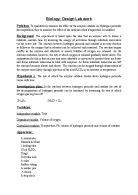Hypothesis:
As amylase is secreted in saliva and pH of saliva is 7,0 pH we assume that this value of pH is an optimal value for the activity of this enzyme. The amylase therefore will best digest starch when pH is neutral (7,0 pH) - when no acidic or basic solution is added.
Planned method:
In the examination usage of substances of different pH is planned.
To obtain:
- acidic solution: 0,1 mol of HCl will be prepared
- basic solution: 0,1 mol of NaOH will be prepared.
Also usage of: buffor, Lugol’s Iodine, starch and salivary amylase.
Six test tubes will be prepared:
- Test tube 1: NaOH + starch + amylase
- Test tube 2: NaOH + starch
- Test tube 3: HCl + starch + amylase
- Test tube 4: HCl + starch
- Test tube 5: buffor + starch
- Test tube 6: buffor + starch + amylase
To every test tube Lugol’s Iodine will be added to notice the color of content.
Expected Results:
Lugol’s Iodine reacts with starch to give a dark blue color. I assume that the color in the test tubes with amylase will change and probably in the neutral pH starch will be digested best and color of the content will become transparent. Supposedly amylase in the acidic and basic solutions will digest starch poorly and solutions will not become transparent.
Materials used:
- Buffer solution at 7pH
- 0.1 mol NaOH
- 0.1 mol HCl
- 1% starch solution
- 6 test tubes
- Test-tube holder (+ rack)
- Distilled water
- Solution of saliva mixed with distilled water
- Indicator papers
- Lugol’s iodine
Variables:
Controlled variables:
6 test tubes are made from the same material, glass and have the same size. In 2 test tubes there is the same amount of the same solution of HCl (30 ml).
In 2 other test tubes there is the same amount of the same solution of NaOH (30 ml).
In 2 other test tubes there is the same amount of the same buffor added (30 ml).
In all 6 test tubes there is the same amount of starch.
The Luglol’s iodine added comes from the same bottle and is added in the same amount to all test tubes.
To one of two test tubes with HCl, to one of two test tubes with NaOH and to one of two test tubes with buffor the same amount of amylase was added.
The temperature is kept at the same level.
Independent variables:
Different solutions added to particular test tubes (NaOH, HCl, buffor, Lugol’s iodine, amylase).
Dependent variable:
The color of each solution changes depending on its ingredients.
Method used:
- A mix of 10 cm3 of distilled water with saliva was added to each test tube.
- 30 ml of starch was added to every of the total 6 test tubes.
- To the first and second test tube 30ml of NaOH was added, to make pH basic.
- To the third and fourth test tube 30 ml of HCl was added to make ph acidic.
- To the fifth and the sixth test tubes with starch and amylase buffor was added.
- All the test tubes were labeled.
- Lugol’s iodine was added to every test tube, to check the solution for the presence of sugar.
Results:
THE COLORS OF THE SOLUTIONS AFTER ADDING LUGOLA’S IODINE:
Evaluation:
The results of the research followed the hypothesis.
In the test tubes with no amylase reaction of starch with Lugol’s Iodine occurred giving dark blue color. In test tubes with amylase digestion of starch occurred. However, differences between the speed of reaction was seen. In the test tube with buffor only (pH 7.0) a transparent solution was obtained which means total digestion of starch there. In basic and acidic solutions the color changed from dark blue which means a partial digestion.







